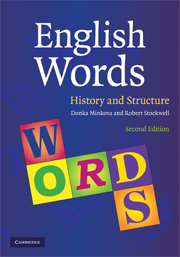Book contents
- Frontmatter
- Contents
- Preface to the second edition and acknowledgements
- An introduction to the textbook
- 1 Word-origins
- 2 The background of English
- 3 Composition of the Early Modern and Modern English Vocabulary
- 4 Smaller than words: morphemes and types of morphemes
- 5 Allomorphy, phonetics, and affixation
- 6 Replacement rules
- 7 Deletion rules and other kinds of allomorphy
- 8 Fossilized allomorphy: false cognates and other etymological pitfalls
- 9 Semantic relations and semantic change
- 10 The pronunciation of classical words in English
- Appendix: morpheme list
- Index
7 - Deletion rules and other kinds of allomorphy
Published online by Cambridge University Press: 05 June 2012
- Frontmatter
- Contents
- Preface to the second edition and acknowledgements
- An introduction to the textbook
- 1 Word-origins
- 2 The background of English
- 3 Composition of the Early Modern and Modern English Vocabulary
- 4 Smaller than words: morphemes and types of morphemes
- 5 Allomorphy, phonetics, and affixation
- 6 Replacement rules
- 7 Deletion rules and other kinds of allomorphy
- 8 Fossilized allomorphy: false cognates and other etymological pitfalls
- 9 Semantic relations and semantic change
- 10 The pronunciation of classical words in English
- Appendix: morpheme list
- Index
Summary
This chapter turns to deletion rules, as well as other kinds of allomorphy, some of which can be recovered only historically. The first set of changes to be considered produces allomorphic variation due to the dropping of one or more sounds from the edges of the original forms of roots or affixes. Like replacement rules, deletion rules must be defined in terms of both the phonological environment and the type, position, and number of morphemes involved in the change.
Consonant deletion
More on double consonants. The general principle which governs the simplification of double consonants to single ones, phonetically, is that English, unlike Italian, Finnish, and many other languages, does not allow “long” or “double” consonants within a word. Our discussion of double consonant spelling in Chapter 6, Section 4.2, pointed out the important distinction between double consonants in the spelling, which can arise as a consequence of total assimilation, and “long” consonants in the pronunciation. Morpheme-internal double consonant letters are not pronounced “long”: balloon and saloon have only one [l], lemma and lemon have only one [m], and peddle and pedal have the same short consonant in the middle.
English allows real “long” consonants, but only at clear word and morpheme boundaries: file log, big garden, roommate, bus-schedule, bookcase, sad day, unnoticed, dissatisfied, etc. The phonetic nature of the abutting long consonants is not identical: the one to the left is “unreleased,” because it is syllable-final, but the one to the right is fully released into the following segment in the syllable to the right.
- Type
- Chapter
- Information
- English WordsHistory and Structure, pp. 126 - 141Publisher: Cambridge University PressPrint publication year: 2009



